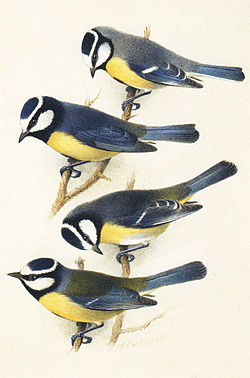| African blue tit | |
|---|---|
 | |
| Scientific classification | |
| Kingdom: | Animalia |
| Phylum: | Chordata |
| Class: | Aves |
| Order: | Passeriformes |
| Family: | Paridae |
| Genus: | Cyanistes |
| Species: | C. teneriffae |
| Binomial name | |
| Cyanistes teneriffae (Lesson, 1831) | |
 | |
| Synonyms | |
Parus teneriffaeLesson, 1831 | |
The African blue tit (Cyanistes teneriffae) is a species of bird in the family Paridae. It is found in northern Africa, Pantelleria (Italy) and the Canary Islands (Spain). Its natural habitat is temperate forests. This species and the Eurasian blue tit were formerly considered conspecific. The status of this species has not been assessed because it is noted to be common on the islands of Tenerife and Gran Canaria. The species has been used in many research studies due to its island populations and relevance to evolutionary hypotheses. [2]


